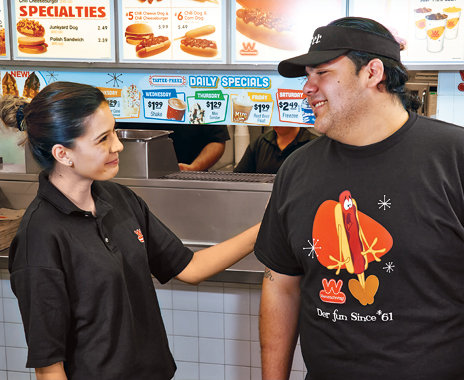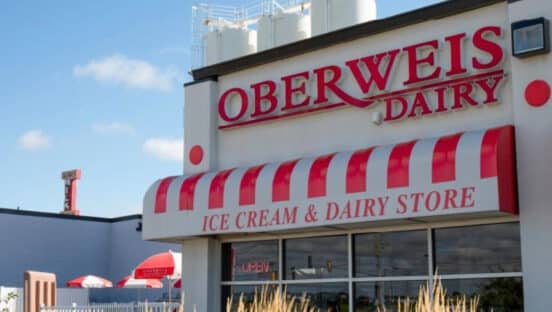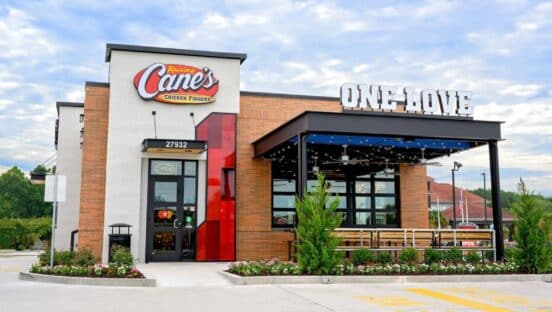Although the limited-service industry was built on the pillars of convenience and speed, the human factor is what sets brands apart. The front line of general managers, cashiers, and servers is where the customer’s experience begins and ends, and operators say that it can mean the difference between a repeat or one-time visit.
“The basic need people have when they come to us is for food,” says Patrick Yearout, director of recruiting and training at Sea-ttle-based Ivar’s Seafood Restaurants, which includes the quick serve Ivar’s Seafood Bar. “But they could fill that physical need by heating up a microwave burrito from the freezer. So why do people get dressed, get in their car, and drive several miles to pay good money at Ivar’s or any other restaurant? Because they want to feel pampered, special, and like they belong.”
Elements of great customer service can be taught, but the process begins by hiring the right people, says Jeff Tenut, cofounder and vice president of solution design for e-learning company DiscoverLink. “You want employees to be themselves first and foremost, which backs up to hiring,” he says.
Tenut says that looking for cues like eye contact and inquisitiveness during the interview process helps give a sense of how that candidate might interact with guests on the floor. But it also helps to look at a person’s extracurricular activities.
“We often recommend hiring people who are studying theater in school or people who play sports—highly active team sports in particular, like cheerleading,” Tenut says. “They’re used to working with other people and interacting quite often, and they tend to rally well together and keep the energy up.”
Ivar’s places huge emphasis on the interview process to pick out those who will succeed in a demanding environment. (Yearout thinks not doing so is partly to blame for the industry’s high turnover numbers.) Managers ask open-ended, neutral questions—such as candidates’ previous position, boss, and working environment—gauging for positive responses.
Those positive responses connote a positive personality, and as long as applicants have the right personality and drive to succeed, operators can train for technical skills, Yearout says.
Reading customers’ signs
Once onboard, making genuine personal connections can be challenging in an environment that values speed and convenience first. But even small cues that facilitate the process for customers can leave an impact, operators say.
“Too often, quick-serve employees focus solely on the steps of service because that’s how they’re taught,” Tenut says.
Even assigning names rather than numbers to orders can make a harried lunch rush feel more personal. California–based Wienerschnitzel recently redesigned its POS system to require a name for every order taken, which has helped cashiers remember guests’ names. The chain also trains cashiers to hand customers their food rather than leaving it on the counter.
“Even though we’re pushing people through quickly, if they hear, ‘Mary, your order’s ready,’ and they’re handed their food with a smile, that creates a positive response,” says Bryan Frame, training program developer for Wienerschnitzel’s parent company, Galardi Group.
The first opportunity to engage arises the second a consumer walks through the door. “Every guest is holding a sign that says, ‘I’m important,’” says Peggy Rubenzer, senior vice president of people resources at New York City–based Shake Shack. “Some are bigger and bolder, some are in really small font, but you have to gauge which kind of a guest you have.”
Shake Shack’s training program pre-sents this process of determining what they mean and how an employee might respond as a grid. “If a person is fidgeting, acts confused, has their arms folded, or is not making eye contact, we don’t try to script it, but we like to give examples of ways they might respond,” she says.
To keep cashiers from sounding scripted at Denver-based Larkburger, all employees not only taste the entire menu, but also observe cooks preparing popular items, such as the truffle aioli and twice-cooked french fries, says chief operating officer Wayne Humphrey.
Given that the concept features a limited menu of high-quality food, employees should understand the flavors, prep, and culinary technique, Humphrey says. This type of training encourages employees to speak authentically about various options.
Larkburger discourages use of the word “everything” (as in, “How is everything?”) in employee and guest interactions since Humphrey says it doesn’t sound sincere.
You’re only as good as your manager
Tenut says a good way to inspire authentic customer interactions is through role modeling, whereby employees observe managers or other front-of-house employees who are good at forging connections.
“Employees need to see managers in action with guests,” he says. “They can also do things during pre-shift meetings to help mix it up and challenge the team. Maybe it’s raining outside and they can ask team members to each do one different thing that will help. Or compliment guests’ shoes that look new. These kinds of activities help make it something they think about every day.”
Ivar’s managers not only monitor and coach employees at the various interaction stages during a customer visit, but they also collect and relay consumer reviews. The chain collects this information through an online customer feedback service, which Yearout says has helped a lot in improving customer service.
Last year, the brand received nearly 10,000 responses across its concepts and locations. Yearout says it’s then up to the managers to translate that data—both the good and the bad—into action. The feedback should be shared with the crew so the restaurant can improve, he says.
Fostering connections
Managers can also provide a conduit between quick serves and their communities. Larkburger doesn’t rely on limited-time offers or special deals to entice new customers. Instead, it takes a local relationship marketing approach by sending managers out in the community to sample products and connect with potential customers and those who haven’t been back in a while.
“We try to carve a pretty tight circle—within a mile or so—to keep it really truly local, and we like to have the managers be involved because they bring a sense of knowledge,” Humphrey says.
Furthering this strategy inside the restaurant, managers empower cashiers to give out free entrées or desserts from time to time—whether to encourage a regular to try a new menu item or to give a small serving of ice cream to a child who’s finished his meal before his parents.
“We use sampling instead of advertising dollars, letting the food be our currency,” Humphrey says.
Wienerschnitzel, which is entirely franchise-owned, covers 50 percent of the cost of local-store marketing to incentivize franchisees to become involved. Frame says these reimbursements make it easy for franchisees to connect with the local community. Recently, a franchisee in Riverside, California, partnered with the local Red Cross chapter by offering free chili cheese fries to anyone who gave blood.
Shake Shack selects local charities to support in each community where it operates, but it also strives to be a good neighbor, Rubenzer says.
“Our Upper West Side location is right across from the Museum of Natural History, so our bags, boxes, and cups often end up strewn around the area and filling the trash cans,” she says. “We will go and clean up the area and empty the trash. The local community really appreciates us for it; they like to have neighbors like that.”













